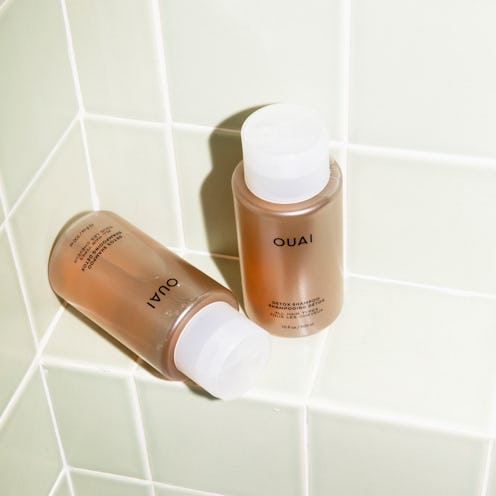(Beauty)
OUAI’s Newest Launch Is Here To Save Your Hair From All That Dry Shampoo

While you'll be forever grateful for your reliable rotation of dry shampoo, heat protectant, and mousse to get you camera-ready for a day of video calls, there's only so much product your hair can take before it needs a good washing. And while skipping washes is good for it, product overload from what you use to stretch the time between washes is where it gets tricky. So, if your overloaded strands are in need of a reset, you'll be happy about the perfectly timed arrival of OUAI's new Detox Shampoo, which is designed to leave you with clean hair — like, actually clean hair.
The new $30 product is available at Sephora on April 17 and OUAI's website starting April 20. Its intent is to serve as a once- or twice-a-week shampoo that deep cleans without adding more buildup, which is something that the founder of OUAI and celebrity hairstylist Jen Atkin found that many customers were wanting. "We heard so many people talk about how they were able to go longer in between washes with all the resources available to them in the hair space, but then realized that because of all this product buildup, they needed a deeper wash. Hence, Detox Shampoo," says Atkin in an email to The Zoe Report.
The secret to its cleansing powers? A simple ingredient you probably have in your pantry right now. "Apple cider vinegar (ACV) is super clarifying, helps balance the scalp and hair’s pH levels, and restores our natural bounce and shine," says Atkin. "It’s such a power product, and it would be hard to create a high-quality detox shampoo without it."
However, if you've ever used the ingredient for anything, you know its aroma is not exactly... pleasant. So naturally, the brand (which is well known for its beautifully scented products) took that issue into account. "But real talk, the smell is intense, we all know that if we’ve tried an ACV rinse before. Which is why we paired all of these yummy ingredients with Melrose Place," explains Atkin. "There was no reason the experience of detoxing your hair had to be unpleasant to the senses, which is one of the reasons I’m so proud of the outcome," Atkin says.
But of course, apple cider vinegar isn't the only power ingredient in this launch. The formula also includes chelating agents (to help remove heavy metals, minerals, and chlorine) and hydrolyzed keratin (which reduces frizz by filling in missing keratin naturally found in the hair follicle). Together, that results in a mixture that helps keep your hair strong, clean, and residue-free.
With all this talk of detoxing, you might be wondering if your hair even needs it — and if it does, how are you supposed to know? According to Atkin, when and how you decide to use the product is up to you. "Only you can best gauge the health of your hair, of course with our education and the advice of your stylist. But the general rule of thumb for a deeper cleanse is once or twice a week," Atkin says.
If you're still unsure, she suggested this tip: "It’s gross, but you can get a really good sense of your hair’s readiness by scratching your hair at the root, and seeing how much gunk is under your fingernail. If there’s a lot, then yes, it’s time to detox. If you know your environment has been more stressful than usual, if the seasons are changing, if your hormones are up and down, if you’ve been using a ton of styling product all week, then you know it’s probably time," she says. And if it is time, just use it in place of your regular shampoo and finish with conditioner after rinsing.
Shop the new shampoo, below.
We only include products that have been independently selected by The Zoe Report's editorial team. However, we may receive a portion of sales if you purchase a product through a link in this article.
This article was originally published on